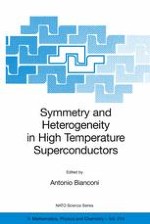2006 | Book
Symmetry and Heterogeneity in High Temperature Superconductors
Proceedings of the NATO Advanced Study Research. Workshop on Symmetry and Heterogeneity in High Temperature Superconductors Erice, Sicily, Italy October 4–10, 2003
Editor: Antonio Bianconi
Publisher: Springer Netherlands
Book Series : NATO Science Series II: Mathematics, Physics and Chemistry
